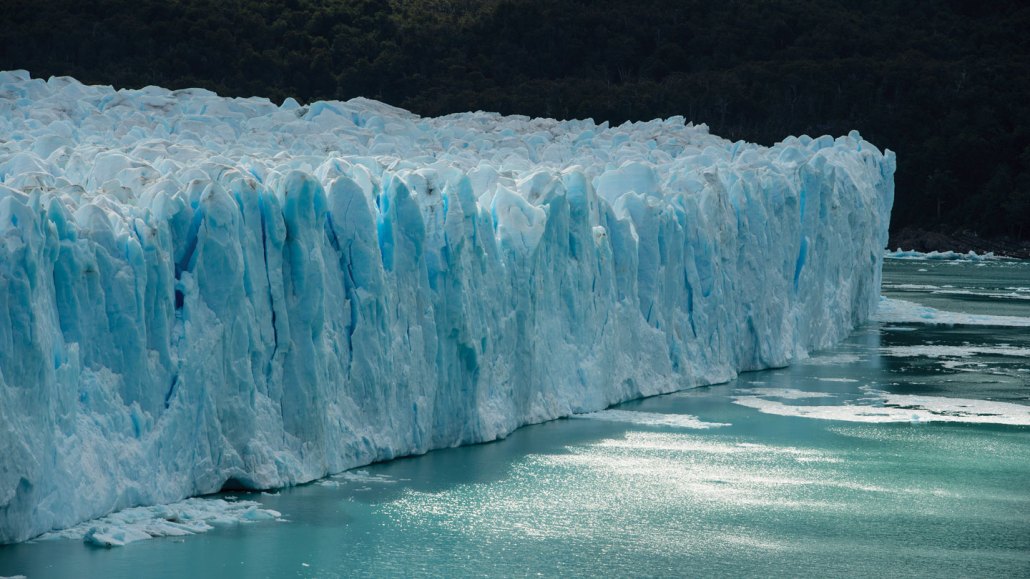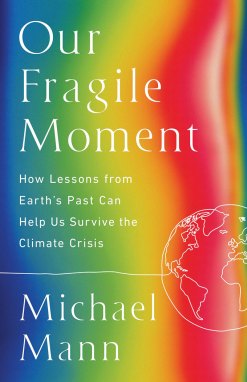
Human-caused global warming threatens one of Earth’s natural climate regulators — glaciers (the Perito Moreno Glacier in Argentina is shown).
Cavan Images/Getty Images
- More than 2 years ago

Our Fragile Moment
Michael Mann
PublicAffairs, $30
Over four millennia ago, in the final days of the Akkadian Empire in Mesopotamia, a drought swept over the region, afflicting lands as far away as Greece and what’s now Pakistan. Probably driven by the eruption of a distant volcano, the drying climate devastated local agriculture. A contemporary text, The Curse of Akkad, noted that “the large arable tracts yielded no grain … the irrigated orchards yielded no syrup or wine, thick clouds did not rain.”
As once-prosperous farmlands collapsed in the northern part of the empire, people fled to the south. The southern Akkadians’ response? Build a more than 150-kilometer-long wall between the Tigris and Euphrates rivers, barring entry to any migrants. Soon after, history’s first empire crumbled, dying of thirst in the cradle of civilization.
Climate systems and civilizations are stable only up to a point. In Our Fragile Moment, climate scientist Michael Mann reminds us that today we are pushing the limits of both.
In the book, Mann looks back at episodes of global climate change over the last 4.5 billion years, from eras of deadly heat to wastelands of widespread ice. With each instance, he draws out lessons about what happens to Earth in periods of changing climate. Sometimes, the result is dramatic mass extinctions or geologic upheavals (SN: 8/28/15). Other times, as with the Akkadians, it’s societal collapse.
Earth’s climate system includes regulating forces that tend to buffer against small shifts in climate; ice caps and low clouds reflect sunlight and help cool the planet, for instance. But pushed too far, regulating forces can be overwhelmed, causing the climate to spiral out of control.
This was the case 55 million years ago. As a steady set of volcanic eruptions spewed carbon dioxide into the air, Earth warmed. The heat may have contributed to thinner and less reflective clouds. This in turn would have made the planet even hotter. Eventually, the low-lying clouds disappeared, and average global temperatures soared to 32° Celsius (90° Fahrenheit) in what is referred to as a Hothouse Earth (SN: 11/3/15).
Today, with unchecked greenhouse gas emissions, we may face a similar, though less sweltering, spiral with the disappearance of our reflective ice caps (SN: 11/9/22).
But what makes current climate change different is its source — humankind — and our ability to stop it. This is a benefit that is unique to our changing climate. It comes with blame, but it also comes with agency.
That agency is an important source of hope for Mann. Melting ice caps could raise sea levels and displace some 40 percent of the global population. Rising heat could make swaths of the planet uninhabitable (SN: 5/8/20). But if we act, we can preserve a world that looks much like ours. The limit is not geologic or even technological, Mann argues; it is political.
Despite the far-reaching themes Mann weaves throughout the book, it may not be for everyone. There is a strong academic bend to the writing, which leans heavily on jargon. The book also features a dizzying parade of researchers, and Mann often emphasizes his connection to climate researchers and events, at one point reminiscing about how he “was known as a bit of a statistics guru.” The technical terms, acronyms, initialisms and self-referential tangents can distract from the book’s broader arguments and message.
Even though Mann’s dedication to precise academic language comes at the expense of some clarity, climate buffs will appreciate the deep dives into the scientific process. Many of the dense sections reward the reader with a satisfying tidbit of fascinating information or an illuminating insight. On occasion, I laughed out loud at Mann’s puns, jokes and barbs. (A reference to The Princess Bride’s ROUSs — Rodents of Unusual Size — landed particularly well.)
After journeying through the past, Mann brings us to the present and looks toward the future. Though past climates may offer lessons, those lessons only go so far. We are unlikely to bring about another Hothouse Earth, but the climate is warming faster than it has in millennia, thanks to human actions. If current climate policy holds, the best scientific predictions show things will be painful, but civilization won’t end. But climate scientists are not oracles. They can’t be sure.
That uncertainty, rather than being a cause for complacency, should spur us to action, Mann argues. “The impacts of climate change, no doubt, constitute an existential threat if we fail to act,” Mann concludes. “But we can act. Our fragile moment can still be preserved.”
Buy Our Fragile Moment from Bookshop.org. Science News is a Bookshop.org affiliate and will earn a commission on purchases made from links in this article.







